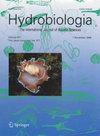The utility of urohial shape in the discrimination of Pisces: Mugilidae species and local population
IF 0.3
4区 生物学
Q4 MARINE & FRESHWATER BIOLOGY
引用次数: 0
Abstract
ABSTRACT: Background. The exploration of new structures allowing species identification is relevant for fisheries science since it permits to be managed according to their specific characteristics. The urohial is a specific structure of bony fish. The Pisces: Mugilidae is a family with very conserved morphology, so finding a structure useful to discriminate species and/or populations is a pending task. Goals. Thus, the objective is to determine the usefulness of the urohial bone shape on its lateral, dorsal and ventral view in species discrimination: Mugil cephalus and M. curema and in location discrimination, two from the Gulf of Mexico and one for the Mexican Pacific. Methods. Urohial shape was analyzed using the Procrustes method were the relative warps were submitted to discriminant analyzes and MANCOVA in order to detect differences in lateral, dorsal and shape among species and localities (α = 0.05 p <0.05). Results. Cross-validation percentages of classification percentages by species were 86.6, 96.5 and 95.1% for lateral, dorsal and ventral views, respectively where the dorsal view in addition to being the one that showed the highest percentage of classification was less influenced by size. Among locations for M. curema percentage of classification were 65.9, 54.9, and 60.4%, respectively, and for M. cephalus were 66.7, 49.0 and 56.9%, respectively. Size did not influence the uriohial shape, except in the ventral view for M. cephalus. Conclusions. The urohial bone was useful for the discrimination of species, particularly in its dorsal view, while it was less suitable for discriminating between localities.尿路形态在双鱼科和当地种群鉴别中的应用
文摘:背景。探索允许物种鉴定的新结构与渔业科学有关,因为它允许根据它们的具体特征进行管理。尿路是硬骨鱼的特殊结构。双鱼座:Mugilidae是一个形态非常保守的科,所以找到一个有用的结构来区分物种和/或种群是一个悬而未决的任务。的目标。因此,目的是确定尿路骨形状在其侧面,背侧和腹侧视图中的物种识别的有用性:Mugil cephalus和M. currema以及位置识别,两个来自墨西哥湾,一个来自墨西哥太平洋。方法。采用Procrustes法分析尿路形态,将相对翘曲进行判别分析和MANCOVA分析,以检测不同物种和不同部位的尿路外侧、背侧和形状的差异(α = 0.05 p <0.05)。结果。侧视图、背视图和腹视图按物种分类百分比的交叉验证百分比分别为86.6、96.5和95.1%,其中背视图除了是显示分类百分比最高的视图外,受大小的影响较小。其中,金缕螨的分类率分别为65.9、54.9%和60.4%,头缕螨的分类率分别为66.7、49.0%和56.9%。大小不影响尿路形状,除了在腹侧视图的头分枝杆菌。结论。尿路骨对物种的区分是有用的,特别是在它的背侧视图,而它不太适合区分位置。
本文章由计算机程序翻译,如有差异,请以英文原文为准。
求助全文
约1分钟内获得全文
求助全文
来源期刊

Hidrobiologica
生物-海洋与淡水生物学
CiteScore
0.40
自引率
0.00%
发文量
8
审稿时长
>12 weeks
期刊介绍:
HIDROBIOLÓGICA es una publicación cuatrimestral que difunde trabajos originales e inéditos de investigación o revisión, sobre temas relacionados con los organismos y la hidrología de los ambientes acuáticos, dulces y marinos y va dirigida a investigadores de todo el mundo, interesados en las diversas disciplinas que incluye la Hidrobiología , así como a alumnos de posgrados y licenciaturas relacionados con la biología, ecología, taxonomía, filogenia y evolución de organismos acuáticos, e hidrología y oceanografía de ambientes s dulceacuícolas y marinos.
 求助内容:
求助内容: 应助结果提醒方式:
应助结果提醒方式:


